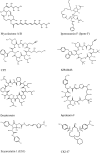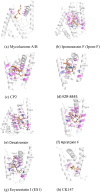Toward Understanding the Mechanism of Client-Selective Small Molecule Inhibitors of the Sec61 Translocon
- PMID: 39394908
- PMCID: PMC11695074
- DOI: 10.1002/jmr.3108
Toward Understanding the Mechanism of Client-Selective Small Molecule Inhibitors of the Sec61 Translocon
Erratum in
-
Correction to "Toward Understanding the Mechanism of Client-Selective Small Molecule Inhibitors of the Sec61 Translocon".J Mol Recognit. 2025 Sep;38(5):e70010. doi: 10.1002/jmr.70010. J Mol Recognit. 2025. PMID: 40769512 No abstract available.
Abstract
The Sec61 translocon mediates the translocation of numerous, newly synthesized precursor proteins into the lumen of the endoplasmic reticulum or their integration into its membrane. Recently, structural biology revealed conformations of idle or substrate-engaged Sec61, and likewise its interactions with the accessory membrane proteins Sec62, Sec63, and TRAP, respectively. Several natural and synthetic small molecules have been shown to block Sec61-mediated protein translocation. Since this is a key step in protein biogenesis, broad inhibition is generally cytotoxic, which may be problematic for a putative drug target. Interestingly, several compounds exhibit client-selective modes of action, such that only translocation of certain precursor proteins was affected. Here, we discuss recent advances of structural biology, molecular modelling, and molecular screening that aim to use Sec61 as feasible drug target.
© 2024 The Author(s). Journal of Molecular Recognition published by John Wiley & Sons Ltd.
Conflict of interest statement
The authors declare no conflicts of interest.
Figures





Similar articles
-
Rough microsomes isolated from snap-frozen canine pancreatic tissue retain their co-translational translocation functionality.Biol Methods Protoc. 2025 Jun 2;10(1):bpaf044. doi: 10.1093/biomethods/bpaf044. eCollection 2025. Biol Methods Protoc. 2025. PMID: 40585179 Free PMC article.
-
A light-resuming strategy as a screening method for selecting Sec61 inhibitors down-modulating PD-L1 expression.Nat Commun. 2025 Aug 6;16(1):7243. doi: 10.1038/s41467-025-62439-w. Nat Commun. 2025. PMID: 40770233 Free PMC article.
-
Preclinical characterization of novel multi-client inhibitors of Sec61 with broad antitumor activity.J Pharmacol Exp Ther. 2025 Jun 14;392(8):103634. doi: 10.1016/j.jpet.2025.103634. Online ahead of print. J Pharmacol Exp Ther. 2025. PMID: 40669140
-
Exploring the ER channel protein Sec61: recent advances in pathophysiological significance and novel pharmacological inhibitors.Front Pharmacol. 2025 Jun 4;16:1580086. doi: 10.3389/fphar.2025.1580086. eCollection 2025. Front Pharmacol. 2025. PMID: 40535761 Free PMC article. Review.
-
Systemic treatments for metastatic cutaneous melanoma.Cochrane Database Syst Rev. 2018 Feb 6;2(2):CD011123. doi: 10.1002/14651858.CD011123.pub2. Cochrane Database Syst Rev. 2018. PMID: 29405038 Free PMC article.
Cited by
-
Rough microsomes isolated from snap-frozen canine pancreatic tissue retain their co-translational translocation functionality.Biol Methods Protoc. 2025 Jun 2;10(1):bpaf044. doi: 10.1093/biomethods/bpaf044. eCollection 2025. Biol Methods Protoc. 2025. PMID: 40585179 Free PMC article.
References
-
- Osborne A. R., Rapoport T. A., and van den Berg B., “Protein Translocation by the Sec61/SecY Channel,” Annual Review of Cell and Developmental Biology 21 (2005): 529–550. - PubMed
-
- Corsi A. K. and Schekman R., “Mechanism of Polypeptide Translocation Into the Endoplasmic Reticulum,” Journal of Biological Chemistry 271 (1996): 30299–30302. - PubMed
-
- Palade G., “Intracellular Aspects of Protein Synthesis,” Science 189 (1975): 347–358. - PubMed
Publication types
MeSH terms
Substances
Grants and funding
LinkOut - more resources
Full Text Sources

